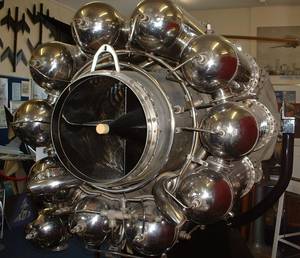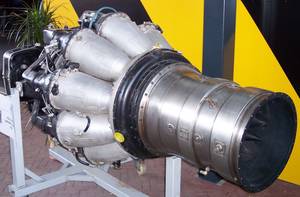How a Jet Engine Works
Interview with
Dave - How do jet engines actually work? One simple way to think about it is Suck, Squeeze, Bang, Blow. The engine sucks air in the front, compresses it, adds fuel which burns, expands and is blown out of the back, producing thrust and pushing the plane along. To get a more detailed idea of the physics behind the jet engine, I went along to the Heritage Museum of jet engine manufacturer Rolls Royce in Derby to meet Professor Jim Wickerson...
Jim - We are in the business of creating thrust. We want to get hold of air, throw it behind the engine, and as we accelerate it out of the back of the engine we're going to have a reaction force. That reaction force is going to push the engine through the sky. The engine is attached by pylon to the aircraft. So in the action of pushing the engine, we're going to pull the aircraft through the sky. An aircraft wouldn't move without being pushed.
Dave - So this is essentially very, very basic physics, Newton's second law.
 Jim - There is more to it than that but Newton is a very good start. In order to accelerate this air through the engine, you have to apply a force to it. The thing which is applying a force to this air to accelerate it out of the back of the engine is the engine itself, and then Newton said in his laws that if you apply a force to something, the air, then the air will apply an equal and opposite reaction to the mechanism which is doing this, and that mechanism is called an engine. And then provided we attach the engine by struts which are strong enough to do the job, but not too heavy, then this engine would pull the aircraft through the sky, and that sort of engine is called a gas turbine engine.
Jim - There is more to it than that but Newton is a very good start. In order to accelerate this air through the engine, you have to apply a force to it. The thing which is applying a force to this air to accelerate it out of the back of the engine is the engine itself, and then Newton said in his laws that if you apply a force to something, the air, then the air will apply an equal and opposite reaction to the mechanism which is doing this, and that mechanism is called an engine. And then provided we attach the engine by struts which are strong enough to do the job, but not too heavy, then this engine would pull the aircraft through the sky, and that sort of engine is called a gas turbine engine.
Dave - I guess virtually any aeroplane engine must work on this basic principle because there's nothing else to push on in the sky other than air. So what actually is special about the gas turbine, what we normally call a jet engine?
Jim - The special feature is the higher speed jet which lets us fly faster. So how does it work? What we have available is fuel. Fuel, kerosene, is a very condensed form of energy and we can convert the fuel to this fast moving jet which is going to give us thrust. We then have what's called a heat engine. Car engines, those are heat engines. There's jet engines, those are heat engines. What they do is they take the fuel and they burn it. If you did that burning at ambient pressure we would be stuck with the thermal energy, we've burned fuel we've now got some hot air, and all we'd have done is heat the house or heat the room. The characteristic of all jet engines, car engines, piston engines, whatever, they first of all have a compression stage where the air comes in and gets squashed. We then have a combustor where we burn the fuel and then having squashed first in the compressor, we can then expand the combustion products through turbines which drive compressors and then out through the back of the engine. Because we're expanding, we're getting cooler and we're converting some of the thermal energy we created in combustion to the thing we want - work to drive compressors and work to accelerate a jet out the back.
Dave - So is it essentially easier for the air to get out through the turbines at the back of the engine than back through the compressor forwards?
Jim - The air has first of all got to be squashed. If we don't squash the air before we do the combustion process, we'll never later on be able to expand the air and convert some of the thermal energy we've built up by combustion to something useful, so we must squash it first. We have the rotors and stators, these air foils of this axial compressor pushing the air up the hill of pressure. We then have a burning phase where the gas stays at the same pressure but gets much hotter. We then drop the air down through the turbine, we're dropping pressure through the turbine. If you give any gas a pressure drop then it's going to experience a force to accelerate it. If pressure is dropping, the air is going to go faster into the place of lower pressure. So we have a pressure drop through the turbine and in that pressure drop, the gas goes faster. The fast moving gas is aimed through nozzle guide veins at moving turbine blades. The fast moving gas pushes the turbine rotor blades, and they're connected by a shaft to drive the compressor. Now why is the gas going in that direction? Because there's a pressure drop. If there's a pressure drop, the air will follow the direction of the pressure drop. So we're now dropping pressure through the turbine, the air is accelerating, pushing turbines, driving compressors.
Dave - So why is the pressure actually dropping as you leave the engine?
 Jim - Well, the pressure drops twice. There's a pressure drop through the turbine - the turbine is the thing which drives the compressor - then there's another pressure drop through the nozzle. Why do we have pressure drops? Because we have to. You can't get something going fast to then push against the turbine unless there's a force. The pressure drop multiplied by the flow area is the accelerating force, so we must have a pressure drop through the turbine to get the very fast moving flow which pushes the turbine. Now, the way we get a lot of force on one turbine, so we don't need many turbines, is by having the gas going very fast. Typically, through a Rolls Royce 'Trent' engine at take off, we've got 200 kilograms a second of core flow. We accelerate that 200 kilograms of core flow to 1000 litres a second, or 2000 miles an hour. As we get that fast moving flow, we impact it onto the turbine blades, and as we turn through the turbine we get a lift force of about 20 tons, so that's a large force on one turbine so we don't need many turbines to drive the compressor. They actually travel at the speed of sound, these turbine gases, and it's the speed of sound in a hot gas. You may know that the speed of sound in air is 330 meters per second. We've got a hot gas, so the speed of sound is three times as much, so we're travelling at about 1,000 metres per second, so that fast moving flow would only go fast because there's been a pressure drop.
Jim - Well, the pressure drops twice. There's a pressure drop through the turbine - the turbine is the thing which drives the compressor - then there's another pressure drop through the nozzle. Why do we have pressure drops? Because we have to. You can't get something going fast to then push against the turbine unless there's a force. The pressure drop multiplied by the flow area is the accelerating force, so we must have a pressure drop through the turbine to get the very fast moving flow which pushes the turbine. Now, the way we get a lot of force on one turbine, so we don't need many turbines, is by having the gas going very fast. Typically, through a Rolls Royce 'Trent' engine at take off, we've got 200 kilograms a second of core flow. We accelerate that 200 kilograms of core flow to 1000 litres a second, or 2000 miles an hour. As we get that fast moving flow, we impact it onto the turbine blades, and as we turn through the turbine we get a lift force of about 20 tons, so that's a large force on one turbine so we don't need many turbines to drive the compressor. They actually travel at the speed of sound, these turbine gases, and it's the speed of sound in a hot gas. You may know that the speed of sound in air is 330 meters per second. We've got a hot gas, so the speed of sound is three times as much, so we're travelling at about 1,000 metres per second, so that fast moving flow would only go fast because there's been a pressure drop.
Dave - So your gas turbine is using this immense amount of power. Even on a plane, are you just extracting that by the air accelerating out the back of the jet itself.
Jim - Okay, well that takes us on very nicely to turbo jets and turbo fans. What we've talked about so far has been a turbo jet, but in the 1960s, we invented the turbo fan. We add a low pressure turbine downstream of the first turbine. That low pressure turbine drives a huge fan at the front of the engine. The huge fan builds up a little bit of pressure with a lot of air, and throws a large mass back at a low velocity. Having gone through the low pressure turbine, the core air has used up most of its spare pressure, and again, just pops out at a modest velocity. So we've added complexity, we've added cost, we've added weight, we've added engine drag, but we've doubled or tripled the amount of thrust for a given amount of fuel, and hugely reduced the noise because jet noise goes with jet velocity to the 8th power. So as we drop the jet velocity, the noise plummets. If you've ever been sent to listen to a A380 taking off on a radio program, you'd get into a mess because they're so quiet, you can't hear them.
Audio clip provided by Michael Manzke.
- Previous Behind the scenes at Naked Oceans
- Next Communicating Astronomy









Comments
Add a comment